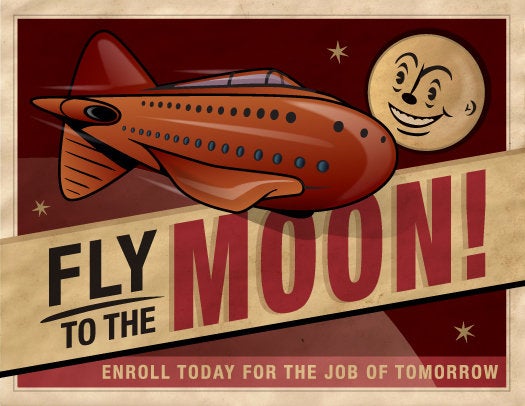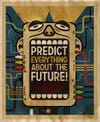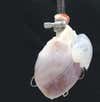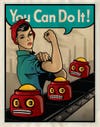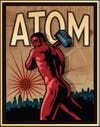Jobs may be scarce today, but if current trends hold, pretty soon there will be plenty of fun, lucrative gigs. If you have the vision to start prepping now, you could be flying starships, reading minds, or manning a fusion reactor. The jobs are coming. Feel free to thank us over lunch at the hotel you built- on Mars.
Click to launch the photo gallery.
Space Pilot
Job: Fly shuttles to space. Hiring: 2020 Trend: Virgin Galactic plans to launch the first commercial suborbital spaceflights by 2012 for about $200,000 a seat. With competition from other companies, that price could soon drop low enough for daily shuttle service to outer space, the moon and asteroids for tourism, mining and science. Commercial pilots will regain the mystique they had in the ’60s as thousands of them strap in for the stars. Education: Aviation school or the Air Force. Also check out NASA’s underwater space-simulator laboratory.
Animal-Migration Engineer
Job: Create new habitats for critters. Hiring: 2030 Trend: Many habitats are now being destroyed faster than a species can evolve. But moving creatures to new homes could save them. After figuring out which species to put where (quite the task), an aassisted migrationa effort requires more care than just piling two of everything into an ark. For example, conservationists who currently relocate butterflies identify suitable sites with aerial photos and trim local plants to the insects’ exacting standards. Education: Intern with a group like Operation Migration, which leads cranes to new watering holes.
Fetus Healer
Job: Cure health problems before birth. Hiring: 2020 Trend: Operating on a fetus was once unimaginable. Now docs fix twins’ abnormal placentas, surgery to correct spina bifida is in clinical trials, and scientists are testing stem-cell and gene therapies in pregnant mice. “We’re trying to cure disease before the baby is born, before it damages the fetus,” says Lori Howell, the executive director of the Children’s Hospital of Philadelphia’s fetal-medicine program. Pediatric DNA banks may someday help cure cancer, autism and diabetes in the womb. Education: Head to an emerging fetal-treatment center such as the Children’s Hospitals of Philadelphia or Boston.
Forecaster of Everything
Job: Analyze data to predict the future. Hiring: 2015 Trend: The U.S. Bureau of Labor estimates that demand for statistics wonks will swell by 20 percent by 2018. As the barrage of data growsa€”tweets, insulin-meter uploads, facial-recognition billboardsa€”we’ll need skilled people to choose what data to pull and how to make it useful. As businesses become more dependent on these analyses, the raw data itself will become a key commodity, creating its own industry. Expect openings for data brokers trading exclusive rights to data portfolios. Education: Study computer science or stats, then enroll in a prediction-proficiency program such as DePaul University’s.
Organ Designer
Job: Make organs from scratch. Hiring: 2020 Trend: Every 90 minutes, someone in the U.S. dies waiting for a transplant. With the senior population doubling by 2050, expect more internal plumbing problems. Medical company Tengion’s simple aneo-organs,a such as bladders, arrive as soon as next year. But we’ll still need to figure out how to fashion trickier organs like lungs, kidneys and hearts, all made using the patient’s own cells to reduce rejection. aIf you’re adding a new fender,a says Tim Bertram, a senior vice president at Tengion, ait has to be the right make and model.a Education: A bioengineering program, such as Wake Forest’s, which is working to grow more than 22 different organs and tissues in the lab
Human/Robot Interaction Specialist
Job: Help robots and people get along. Hiring: 2030 Trend: Robot nurses won’t help Grandpa much if they don’t understand his sarcasm. We’ll need savvy workers making—and remaking—’bots to ensure that they operate seamlessly in our world. And we’ll require help coping in theirs. As droids lure people away from real human contact, expect a demand for specialized therapists to boost people’s social and robotic-al skills. Education: Schools strong in artificial intelligence, such as MIT, Carnegie Mellon University and Stanford University
World Watcher
Job: See it all with satellites. Hiring: 2030 Trend: Multispectral satellites can already spot buried ancient cities and track how temperature, population and ground cover help spread disease. As imaging improves, more reverse-astronomers will look down at our own planet with something like a super-powered, time-lapse Google Earth. Education: Archaeology or geophysics, then grad work in Earth imaging, such as at the University of Wisconsin
Galactic Architect
Job: Build cosmic outposts. Hiring: 2025 Trend: President Obama says that astronauts will reach an asteroid by 2025. Soon we’ll be mining precious metals and making rest-stops to Mars, projects that require buildings and vehicles that can withstand everything from subzero temperatures to extreme radiation. Learning to keep people alive in materials-starved space could help Earth-dwellers, too. aExtreme environments provide lessons for everywhere,a says Larry Bell, a space architect at the University of Houston. aHow do you do more with less? What is recyclable?a Education: A master’s in space architecture, currently available only at the University of Houston
Fusion Worker
Job: Manage fusion reactors. Hiring: 2025 Trend: When ITER starts up in France in 2019, it will be the first thermonuclear reactor with a chance of fusing nuclei together to yield net power. If it works (and that’s a big “if”), about five fusion plants could generate enough gigawatts to power New York City at its peak usage. Fusion jobs will boom, much like nuclear-power ones did in the early ’70s. Jobs—”diagnostic physicist,” “magnet auxiliary officer”—will, er, radiate. Education: Check out the U.S. Burning Plasma ITER Summer School.
Thought Hacker
Job: Read thoughts. Hiring: 2030 Trend: Last year, U.S. lawyers made the first request to introduce a alie-detectinga functional-MRI scan as evidence. Though later withdrawn because of shaky scientific support, mind-reading tech will only get stronger. Neuroscientists led by Jack Gallant of the University of California at Berkeley can already roughly reconstruct what people are seeing just from scanning their brains, and memories, thoughts and dreams could be next. Brain-computer interfaces are also well on their wayaat least one paralyzed man has used a brain implant to move a computer cursor and a robotic arm. Fields including psychotherapy and recreational mind-melding will depend on workers who can see into the mind’s eye. Education: Neuroscience or computer sciencea€”they should converge before we go bionic.
